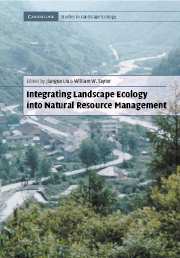Book contents
- Frontmatter
- Contents
- List of contributors
- Foreword
- Preface
- Acknowledgments
- PART I Introduction and concepts
- PART II Landscape structure and multi-scale management
- PART III Landscape function and cross-boundary management
- PART IV Landscape change and adaptive management
- PART V Landscape integrity and integrated management
- PART VI Syntheses and perspectives
- 18 Bridging the gap between landscape ecology and natural resource management
- 19 Landscape ecology of the future: A regional interface of ecology and socioeconomics
- 20 Epilogue
- Index
- Plate Section
18 - Bridging the gap between landscape ecology and natural resource management
Published online by Cambridge University Press: 14 January 2010
- Frontmatter
- Contents
- List of contributors
- Foreword
- Preface
- Acknowledgments
- PART I Introduction and concepts
- PART II Landscape structure and multi-scale management
- PART III Landscape function and cross-boundary management
- PART IV Landscape change and adaptive management
- PART V Landscape integrity and integrated management
- PART VI Syntheses and perspectives
- 18 Bridging the gap between landscape ecology and natural resource management
- 19 Landscape ecology of the future: A regional interface of ecology and socioeconomics
- 20 Epilogue
- Index
- Plate Section
Summary
Introduction
In every respect, the valley rules the stream.
Noel Hynes (1975)The challenges facing natural resource managers occur over entire landscapes and involve landscape components at many scales. Many resource managers are shifting their approach from managing resources such as fish, wildlife, and water separately to managing for the integrity of entire ecosystems (Christensen et al., 1996). Indeed, nearly all resource management agencies in the USA have recognized that informed management decisions cannot be made exclusively at the level of habitat units or local sites. It is generally accepted that ecological patterns and processes must be considered over large areas when biodiversity and ecological function must be maintained while the goods and services desired by the public are provided. For example, forest managers must determine the patterns and timing of tree harvesting while maintaining an amount and arrangement of habitats that will sustain many species. Managers of parks and nature reserves must be attentive to actions occurring on surrounding lands outside their jurisdiction. Aquatic resource managers must broaden their perspective to encompass the terrestrial and human landscape to manage stream and lake resources effectively (Hynes, 1975, widely regarded as the father of modern stream ecology and quoted above; Naiman et al., 1995). Landscape ecology also is implicit in the paradigm of ecosystem management (Grumbine,1994; Christensen et al., 1996).
Despite the acknowledged importance of a landscape perspective by both scientists and resource managers, determining how to implement management at broader scales is very much a work in progress.
- Type
- Chapter
- Information
- Integrating Landscape Ecology into Natural Resource Management , pp. 433 - 460Publisher: Cambridge University PressPrint publication year: 2002
- 16
- Cited by



